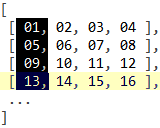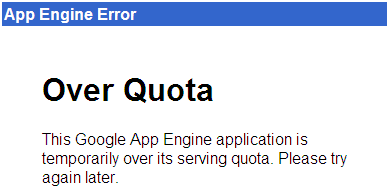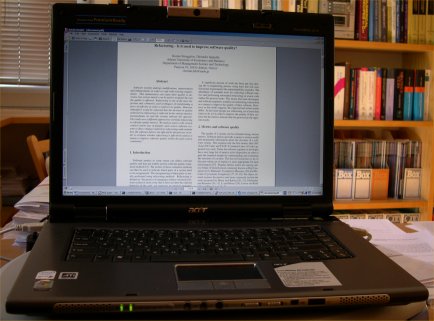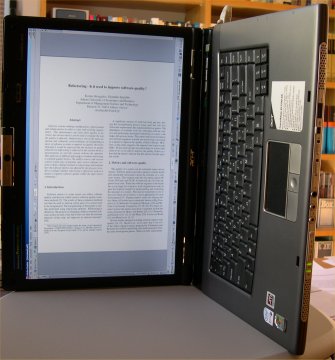The hours in consulting are pretty long. 65 hours a week used to be my norm, and that’s ignoring the travel time to and from work. So there wasn’t too much life outside of work. (I’ve come to realise, though, that what you do outside of work doesn’t change that much with more free time. What does change is that you just enjoy it more — both in and out of work.)
We have a day, once every month or two, where you take time off from whatever project and head back to the office. One such featured a session with the managers telling the consultants how to succeed. Pretty good advice, actually… but that’s not what I’m going to talk about. It’s something about the nature of that advice.
The advice had a lot of TO-DOs and suggestions. Do this. Do that. Focus more on this. Focus a lot on that. Great. Now we know what to do more of.
My question, towards the middle of the session, was: OK, so what do we do less of, then?
You can’t do more of something unless you do less of something else. In most places, it’s easy to answer this with: “Oh, you need to be more efficient.” or “Cut the idle gossip”. For us, none of these were applicable.
The question pretty much remained unanswered. And with good reason. It’s a tough question.
Later, I got involved with a proposal. I wrote a few bits of it. (One page, actually.) Others wrote a few bits of it. And then some standard appendices were added to it. Finally, it ended up as a 180-page document.
The interesting thing is, I can bet no human ever read those 180 pages end-to-end.
I know no one at our end did, because we turned it around in 1 week, and I was the last to assemble the document before sending it out.
I’m guessing no one at the client end did, because they’d have gotten 5 such documents, and had a week to shortlist down to 3.
So if we didn’t read it and they didn’t read it, why did we put it in?
I think I know why. In my IBM days, I had to make a presentation to the management on productivity. I knew nothing of management or productivity. So I put in a report that had a lot of high-sounding words (you know… value-add, leverage, etc.) that looked reasonably impressive and had no basis in fact.
I did that mostly because I was scared. Of seeming to know less. Of being wrong. You know.
(Funnily enough, the presentation was pretty well received. I don’t know if it was because they were polite or had become numb to bullshit.)
This fear is pretty common. I know how that 180-page document ended up as a 180-page document, and I’m sure you’ve seen this happening before. First, here’s a sample conversation at the client end, when they’re writing up a request for information.
Martin: So, what do I put in the RFI?
Clive: Here’s a template we used. You can use some of that. Ask Nick for the one he used last month, and Natalie for hers. Maybe you should get something from our procurement team and information security group to be on the safe side.
Martin: And how do I make the RFI out of this? (BTW, this is a “bold” question that’s rarely asked.)
Clive: Well, make sure you cover everything from all of these documents.
So the RFI asks asks:
- if any of your 80,000 employees are a member of any one of the following 340 organisations that are considered disruptive,
- how many employees you have in each geography, function and vertical — where the break-down provided is as per their definitions (we cook up numbers which, if you add up, totals to over 200,000)
- how much you spent on paper-clips last fortnight, and other such intimate corporate P&L secrets
And we answer these. The answers to the above 3 questions were “No”, a table of numbers, and “We are not at liberty to divulge this information…”
Now, looking at the answers above, it still doesn’t add up to 180 pages. It’s hardly half a page. But you’ve got to take the following conversation at our end into account.
Steve: You know, we’ve got to put in some details about our methodologies in this section.
Me: I have.
Steve: Yeah, but maybe we should add more, you know, like supply chain methodologies and change management.
Me: But they’re irrelevant!
Steve: Well, can’t say that. Change management is always relevant. SCM… well, no harm putting it in. They can skip it if they don’t want to read about it.
That’s it, isn’t it? There’s no harm in doing more. I’ll just toss it in. If you don’t want to read it, skip it. I’ll just ask you to do more of these. If you can’t, skip the useless stuff.
An innocuous sounding statement: do more. I tremble whenever anyone suggests it. There’s no defence.
There’s a fundamental belief at work here. That more is better.
This is fueled by a lack of confidence. Put in high-sounding words. They look impressive. What’s missed is that experts use jargon because they understand what it means, and it conveys a lot in few words. Others follow a cargo cult science.
What we lose, though, is subtle.
Firstly, it wastes time. It wastes my time. It wastes your time. But hey, time is not all that important. (I’m not saying this sarcastically. I believe that wasting time is quite OK, really, and it’s not such a big deal.)
What’s more important is that it destroys focus. Some things in the document are important. Most others are not. In a 180-page document, I can’t find the important stuff! It actually does harm to put it in if it’s irrelevant.
That’s the tough tradeoff, really. A tangible incremental value against an intangible loss of focus. The value looks attractive when you’re less confident. The document seems completely unfocused anyway.
So what the heck, put it in.
Do more of this. And that too.
So what can you do? Quite a bit, surprisingly.
Firstly, you’ve got to believe that less is more. The response to “What’s the harm in adding…?” is “It dilutes the message”. There’s two things here. Believing it. And having the courage to say it. Trust me, you really believe it only when you say it.
Next, you’ve got to understand — really understand — before you write or speak. That requires not fooling yourself. And it requires a lot of practice. I’ve had nearly 20 years of training in fooling myself, so it’s an uphill task. Many people are worse off, never having tasted true understanding.
Third, you’ve got to be brave enough to shut up, or say “I don’t know”. Initially, this was tough for me, but I learnt from a friend. I always thought him not-so-smart, but honest. He’d ask, “But why?” and when I’d explain, he’d say, “I don’t understand it.” After two hours of trying to get him to understand, I’d realise that I was the one who never got it in the first place. After a while, I got into the habit of being very prepared before I explained anything to him.
Saying “I don’t know” doesn’t make people think less of you, I’ve found. I know a lot of people disagree with me. One of the most consistent feedbacks I’ve received in the first half of any project or firm I’ve been in is, “He should speak up.” Dammit, I don’t have anything to say! If I know something, I’ll say it. If not, I’ll shut up. Now, despite this feedback, no one’s quite objected to me. And in the second half, they’re always amazed at how much I’ve improved based on the feedback.
The feedback had nothing to do with it, of course. I just happen to know more in the second half of a project.
There’s a reason why your boss wants you to talk. It makes you appear knowledgable. In the short term, that’s good. You talk about “value” and “leverage” and people nod wisely.
In the long term, it makes you less able to say “I don’t know.” (What? This brilliant chap who knew all about value and leverage doesn’t understand our way of calculating ROI?)
It makes you less likely to ask questions.
It makes you learn less.
It makes you dumb.
On the other hand, I’ve learnt to plead ignorance up front. “Do you understand ROI?” “No.” Not even an excuse for it. Frankly, it saves time.
Sometimes, a meeting’s running late, I’m hungry, and I just nod at whatever’s said, and you lose the window of opportunity to ask. Except, I’ve learnt, there’s no such thing as a window of opportunity. If you don’t get it, ask. If they’ve said it thrice, and you still don’t get it, ask. More likely they’re not clear about it.
Postscript: This morning, I had to convert a document into a standard template. My document was 3 pages long. The template (just the headings) was 14 pages long.
Why? Because someone wants all documents in that format. Does it help them? Maybe not. But it has to be done. Standards.
Sometimes, it’s easier to give up. The smart thing is to minimise the effort on pointless work. I took 15 minutes. Beyond a point, I protect myself rather than the poor reader.






